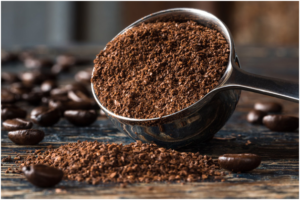Millions of people around the world drink coffee every day. It is among the most popular drinks in the world. Some people like coarse-ground coffee a lot. So, in this article, we’ll tell you what is coarse ground coffee in detail.
Coarse ground coffee is used for French press and other processes that demand a longer extraction time. Cold-brew coffee can also be made using coarse-ground coffee. Coarsely ground coffee has bigger pieces and it looks similar to kosher salt, unlike the coffee you buy at the store.
Let’s move further to learn more details!
What is Coarse Ground Coffee?
The term “coarse ground coffee” describes a specific grind size. People often say that it has larger chunks or a rougher look. It is commonly used for brewing procedures that need repeatedly running hot water over the grounds.
Coarse ground coffee needs more time for the water and grounds to come into contact, making them ideal for slow brewing and extraction techniques. Furthermore, hot water is poured repeatedly over the grounds. A coarse grind can slow the extraction process and extract more surface area from each granule.
It’s perfect if made with immersion and reaches the whole surface.
Why Does Grind Size Matter?

Why does the grind size matter so much? Doesn’t all coffee come from some type of coffee grounds? So, yes. But when you make a cup, you also think about the quality. You can grind the same coffee beans into different sizes. Each type, however, has its own benefits. When brewing coffee, there are three main things to think about:
- Flow rate
- Extraction time
- Contact time
Regarding the grind range, it’s also not as easy as picking a dial number and grinding. Basic coffee grinders offer 10 settings, from fine to coarse.
What is Coarse Grinds Best For?
The best grind for a French press is a coarse one, which makes it hard to make other coffee drinks. Cappuccino, flat white, Latte... all of these coffees are made using espresso, produced with finely ground beans. But you can still make tasty coffee drinks with your coarse grinds and also French press.
Once you figure out how coarse your French press should be, you’ll love making coffee at home that tastes as if it came from a bar. If your coffee tastes too sour, you probably need to make the coffee grounds smaller. If it tastes too bitter, you’ve over-extracted. To fix this, you can either reduce the time you let the coffee soak or use a coarser grind, or you can do both.
What You Should Know about Coarse Ground Coffee
· Extraction
Ground coffee is mixed with hot water in the process of making coffee. Water extracts soluble components from ground coffee. The extracted water-soluble compounds will change the taste and smell of the coffee. Caffeine, acids, sugars, carbohydrates, lipids, and plant fiber are chemicals.
· Grind Size
In an ideal world, extracted coffee would be rich, aromatic, and well-balanced. If you search for what is coarse ground coffee, you’ll know that it’s all about grind size. It would be best to use a grinder to break up coffee beans into equal pieces. When coffee is ground unevenly, some grounds tend to be over-extracted, while others are underextracted. The grind has to be the same, no matter what.
· Brewing Process
The brewing process requires different types of ground coffee to extract soluble components. The complete extraction time is based on the coffee beans’ surface area. Making a well-balanced cup of coffee takes less time with a finer grind setting. On the other hand, coarse grinds take longer to brew and extract. Water takes longer to flow through the coarse ground coffee and extract all the soluble components.
How to Identify the Finest Coarse-Ground Coffee?

Finding the right grind size is the most important part of making a great cup of coffee. For this, you’ll need more information to find the right grind for your taste. Always remember that how you grind your coffee affects how long it takes to make it— affecting how it tastes.
An extra coarse grind can be so chunky that it looks like rock salt. This can be a great way to make lighter extractions if you need a less strong flavour.
If you ground them up a bit, you’d get a coarse powder that still has chunks and looks like sea salt. Next would be the medium-coarse grind, which is less chunky and looks like rough sand. If you own a French press, you can manage the pressure to get good results. This tip will help those who do not know what is coarse ground coffee.
Medium to medium-fine grinds, on the other hand, have smaller granules that make them feel like regular table salt. If you wish to grind them further for a heavier extraction, go for fine grinds with difficult-to-feel and pick-up granules. Lastly, instant coffees that look almost like flour or powdered sugar have the finest grinds and we call them “extra fine grinds.” In some types, water dissolves the granules without filtration.
Also read on: where to buy coarse ground coffee for french press
What Types of Coffee Grinds are there?
Whenever we discuss the type of coffee grinds, the first thing we discuss is the size of the bean.
First, Coarser Coffee Grind
There is not much grinding in coarse coffee, leaving large pieces of beans. As the water seeps from the exterior to the inside over the course of the process, the hot water can only bond to the grinds on the outside.
Second, Fine Coffee Grinds
If you find a grind of coffee, the coffee beans have been ground very well, so the coffee is smooth and powdery. Since the grains are tiny, excellent hot water extracts flavour quicker than the previous one.
Now you are aware of the difference between fine and coarse coffee grinds. But those aren’t the only two kinds; the subtypes are also common. Take a look at a few of these subtypes to get a better idea of how to find the right one for you:
- Coarse grind coffee
- Moderate coarse-grind coffee
- Medium coffee grind
- Moderate fine grind coffee
- Fine grind coffee
- Super fine grind coffee
Conclusion
For all coffee lovers, it’s always best to grind your coffee because it makes the experience out of this world. This post tells you all about what is coarse ground coffee. Now, it’s up to you to make the best coffee.



